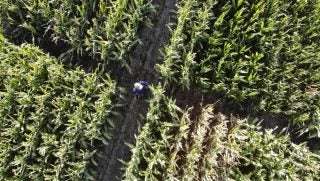Sharing on social media has increased during the coronavirus pandemic as we try to stay connected while spending more time at home. For farm families, photos, and videos of children in the home environment can include hazardous work and play situations, which could sacrifice children’s safety.
“The images we share can, unintentionally, perpetuate unsafe farm practices,” said Scott Heiberger, communications manager with the National Children’s Center for Rural and Agricultural Health and Safety, Marshfield Clinic Research Institute. “Photos and videos are often used as attention-getters, but sometimes ‘cute’ is unsafe.”
About every three days, a child dies in an agriculture-related incident, and each day, at least 33 children are injured.
Images of children performing work that is unsafe for their age and ability level, often involving machinery and large animals, have been common this spring on social media. And it’s not just working children who are exposed to hazards. Of all children injured on farms, more than half are not engaged in work at the time of the injury; they are merely in the worksite. And of those non-working youth, most are younger than 10.
“It’s probably no surprise, then, that many of the unsafe situations we’re seeing on social media involve very young children,” Heiberger said. “One photo showed two little boys climbing on the lift arm of a skid-steer. Another photo showed five small children and the caption, ‘How many kids can you fit on a combine tire? LOL.’
“If we show the agricultural worksite as a playground, we’re asking for trouble.”
Following the old adage that “a picture is worth 1,000 words,” the Childhood Agricultural Safety Network created Media Guidelines for Agricultural Safety, a list of do’s and don’ts aimed at keeping children safe and not perpetuating dangerous farm practices. Examples include:
- Don’t show individuals riding on wagons, in the back of pickup trucks or as extra riders on tractors or ATVs.
- Don’t show children riding on adults’ laps on ATVs, or lawn tractors/riding mowers.
- Don’t show children in proximity to large animals unless appropriate barriers are evident.
- Do show children doing age-appropriate chores under adult supervision and wearing protective equipment.
Child injury prevention resources
The National Children’s Center is the national leader in developing and sharing knowledge and intervention strategies for childhood agriculture safety and health. Among its resources:
Cultivate Safety website: Provides easy access to agricultural safety information and resources for farmers, ranchers, supervisors and media. The website includes sections on Work, Play, Accidents, Parents, Online Tools and a Resource Library with access to hundreds of free safety and health resources.
The Childhood Agricultural Safety Network is a coalition of organizations that work together to help keep children safe on the farm. These organizations represent the agricultural community, child injury prevention, minority-serving associations and related industry organizations.
Safe Play: Creating Safe Play Areas on Farms provides the first comprehensive guide for designing and building an outdoor safe play area on a farm.
Integrating Safety into Agritourism provides checklists, virtual walkthroughs and other resources that help farm owners keep visitors safe.


